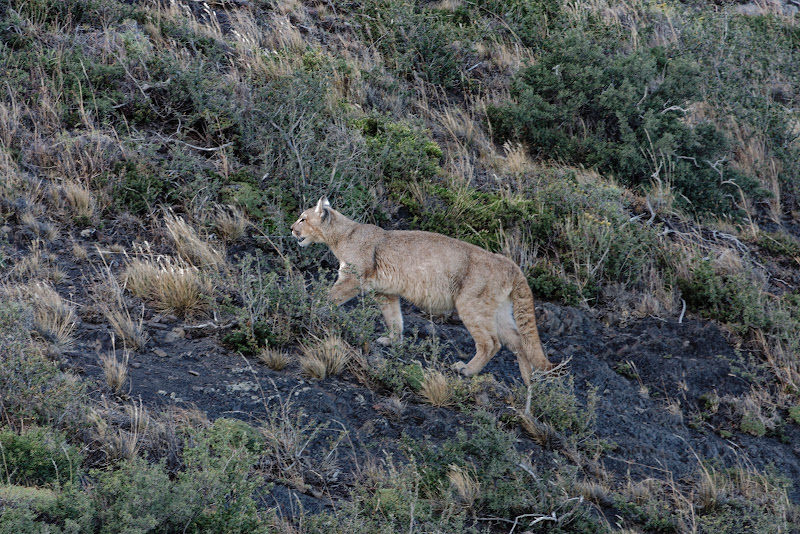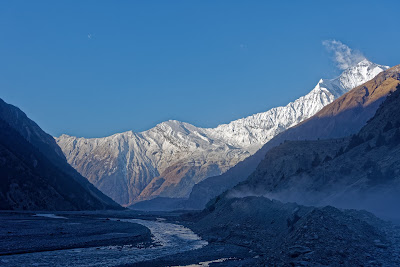Between Torres del Paine NP and Punta Arenas
Jan 19th 2023 - Pumas ahead
With my new tyre I spent a few days in Parque Torres del Paine and a bit north of Lago Pehoe Camping 2 Pumas crossed the road about 30m in front of me. Waited a bit, cycled 50m and looked back, they were still around.
Torres del Paine National Park
Torres del Paine National Park is a protected area in southern Chilean Patagonia. It encompasses mountains, glaciers, lakes, and rivers and is home to the Cordillera del Paine mountain range. The park was established in 1959 and covers 181,414 hectares of land. It is one of the most visited parks in Chile, attracting around 252,000 visitors annually, 54% of whom are foreign tourists.
It is also one of the 11 protected areas of the Magallanes Region and Chilean Antarctica. It features the distinctive three granite peaks of the Paine mountain range (Torres d'Agostini, Torres Central and Torres Monzino), valleys, rivers such as the Paine, lakes (Grey, Pehoé, Nordenskiöld, and Sarmiento) and glaciers (Grey, Pingo, and Tyndall).
The park was named after explorer Florence Dixie, who wrote about the area in her book published in 1880. Several European scientists and explorers visited the area in the following decades, including Gunther Plüschow (the first to fly over the Paine massif) and John Garner, who pioneered the Circuit trail which circles the Paine massif.
Fauna in Torres del Paine National Park
The park is home to many mammals, including guanacos, foxes, pumas and the endangered Chilean Huemul. It also has 15 breeding populations of bird of prey species, as well as other birds like flamingos, rheas, swans, woodpeckers and ibises.
The cougar (Puma concolor) is a large cat native to the Americas. It is an adaptable, generalist species occurring in most habitats and has many common names, including puma, mountain lion, catamount and panther. It is the second-largest cat in the New World and is more closely related to smaller felines than to larger ones. It is secretive and solitary by nature and is considered nocturnal and crepuscular.
It is an ambush predator that pursues a wide variety of prey, including ungulates, rodents and other small animals. Fatal attacks on humans are rare, but have increased in North America as more people enter cougar habitat and build farms.
Intensive hunting following European colonization of the Americas and ongoing human development into cougar habitat has caused populations to drop in most parts of its historical range, with the exception of the isolated Florida panther subpopulation.
Jan 21st 2023 - Puerto Natales
Lazy day in Puerto Natales. Attached are a few pictures from yesterday and from the harbour here in PN.
Jan 22th 2023 - Punta Arenas - Fin del Mundo
In 1.5 days from Puerto Natales to Punta Arenas, the wind only picked up in the afternoon. Staying at Hospedaje Independencia, a remeniscance of camp sites along the Carretera Austral, very informal. Coming up are a bus trip to Ushuaia and a few day trips by bike and foot here in Punta Arenas. Probably a day to see the penguins. Tonight we will eat Curanto at the camp site, probably enough for everyone here, a 40 Liter pot is full with it to the top. pictures taken after the event, small kitchen for 25 people.
Punta Arenas
Punta Arenas is the capital city of Chile's southernmost region, Magallanes and Antarctica Chilena. It is the largest coastal city south of the 46th parallel south and one of the most southerly ports in the world, serving as an Antarctic gateway city. It is also one of only two free ports in Chile, the other being Iquique in the country's far north.
Punta Arenas was founded in 1848 as a penal colony by the Chilean government, and grew rapidly due to waves of European immigrants during the gold rush and sheep farming boom of the late 19th century. It is now a major port for maritime traffic and trade travelling between South and North America.
Its geopolitical importance is still relevant in the 21st century, as it serves as a logistical base for access to the Antarctic Peninsula. The city also has its own time zone, UTC−3, and gets its water from San Juan River.
History
Two early Spanish settlements, Nombre de Jesús and Ciudad del Rey don Felipe (later known as Puerto del Hambre), were attempted along the Straits of Magellan in an attempt to protect Spanish shipping and prevent piracy. The first failed due to harsh weather and difficulty in obtaining food and water, while the second was eventually abandoned after English pirate captain Thomas Cavendish rescued the last surviving member in 1587.
In 1843, the Chilean government sent an expedition to build a fort and establish a permanent settlement on the Strait of Magellan. The settlement was moved to its current location, along the Las Minas River, and renamed Punta Arenas in 1848.
In the mid-19th century, Punta Arenas was used as a penal colony and disciplinary posting for military personnel with problematic behavior. The settlement also received immigrants from Europe and other parts of the world. During this period, two mutinies occurred in Punta Arenas - one in 1851 and the other in 1877 - leading to violence and destruction. Despite these events, the settlement continued to grow as sheep farming, gold mining and trade via sailing ships became increasingly popular.
By 1890, the Magallanes region had become an important sheep-raising region, with one company controlling over 11,000 square kilometres. The harbour of Punta Arenas, although exposed to storms, was considered one of the most important in Chile before the construction of the Panama Canal and was used by ships transiting between the Atlantic and Pacific oceans. Today it is mostly used for tourism cruises and scientific expeditions.
Jan 24th 2023 - A day in Punta Arenas
Waiting for the bus, that will leave tomorrow morning to Ushuaia, 10 hours or more...
Sara Braun Cemetery Punta Arenas
Sara Braun Cemetery is the public cemetery of Punta Arenas, Chile. It has four hectares and is located in the northern area of the city, with three entrances on Bulnes Avenue, Francisco Bilbao, and Angamos streets. The cemetery is at capacity, so a newer cemetery has been built to the north of the city, though the original still remains a "monument cemetery." It was inaugurated in 1894 under the administration of Governor Manuel Señoret, and the area was donated by the pioneer Sara Braun, who also had her name given to the cemetery. The engineer Fortunato Circutti designed the portico and walls that surround it in 1919. Relevant figures in the history of Punta Arenas, such as the great families Menèndez-Behety, Braun Hamburger, Blanchard, Greenshields, Kusanovic, and Menèndez-Montes are buried here, as well as Antonio Soto, leader of the Patagonia Rebelde, and Charles Amherst Milward, British sailor and the inspiration behind Bruce Chatwin's travel classic In Patagonia.




















































































